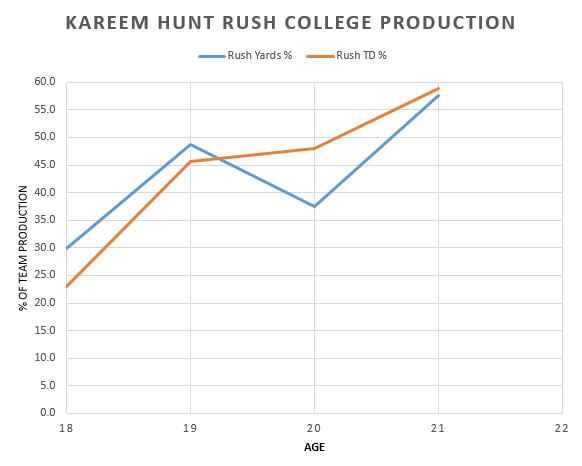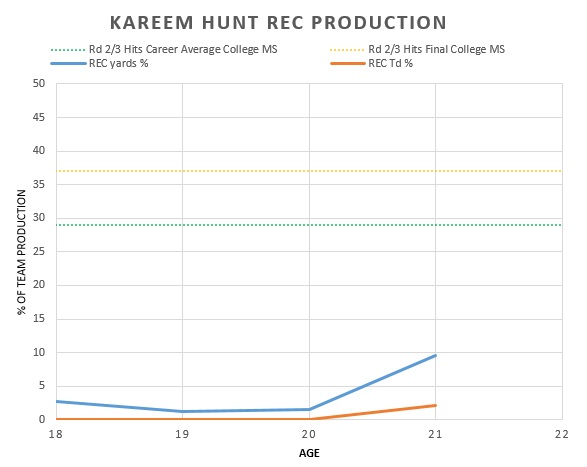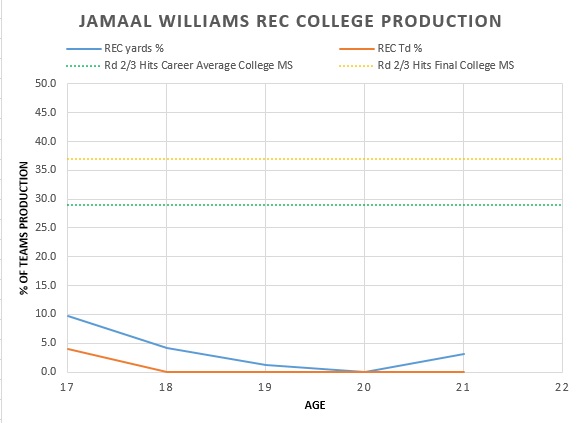Opportunity Plays: Selective Tightrope Walking Across a Narrow Talent Canyon
I knew Kareem Hunt was going to be a problem for me this year. Drafted by the Kansas City Chiefs in the third round, it’s notable that the team traded up to get him behind a player, Spencer Ware, who had surprised with success in the NFL despite poor college production. Hunt looked like a great rookie prospect in rookie drafts. He was; it turns out. His value has increased several times over already, and anyone who drafted him deserves all the happy dances they can spare the time to perform.
Kareem Hunt’s going to be the best rookie running back in fantasy this year.
— JJ Zachariason (@LateRoundQB) August 27, 2017
Even though analysts of the highest caliber like JJ Zachariason had highlighted him early, I had some reservations. I have already lost on this decision, and I’m probably about to lose again by doubling down on it. Hoping that some good may come of my madness, I thought it might be useful to explain why. If nothing else, it should help play a devil’s advocate role for others trying to make their own decisions entering the 2017 season.
The reason I’m fading Hunt is the way I look at opportunity plays in general.
Opportunity Plays
[am4show have=’g1;’ guest_error=’sub_message’ user_error=’sub_message’ ]
These are players you might or might not “like”, but who should get volume based on their situation. A player’s opportunity and situation are pivotal to fantasy. There’s really no way around it. Jeff Janis lovers (and the few of us left who still remember Michael Campanaro’s name) know this all too well. It doesn’t matter how good a player is, or how good you think they are, if he isn’t on the field he doesn’t score you points. Conversely, it doesn’t matter if you think a player is bad (Kelvin Benjamin, Tyreek Hill, Rob Kelley) if they are getting snaps.
In trying to find some nuance to use as an edge I sometimes walk a narrower line over a wider canyon. This is why I try to be selective with opportunity plays.
I lean into some opportunity plays, like Pierre Garcon. I know he’s #good. He’s been a good player, he’s been a great fantasy play before.
I “fade” – or lean out of – volume plays where I don’t think the “talent” is there to take advantage. An example this year would be Robert Woods. He has never proven to be a particular good – fantasy – player. I believed he wouldn’t do enough with any volume of targets to justify the opportunity cost – taking up a roster spot – in most leagues. Since the Sammy Watkins trade, the hype has died down on Woods so we’ll ever know. (But it’s an example of how opportunity can be slippery as well.)
The other danger to how I view opportunity plays is that “talent,” is hard to define and harder to project than opportunity.
But at his newly projected third round draft pedigree, I think Hunt falls almost exactly in the middle of the two extremes. He has a great opportunity, but his profile has an extreme range of outcomes. So he could hit and take full advantage of it, or he could miss and the fade was worthwhile.
Cross the canyon or fall to my death…well, fantasy death…maybe…it’s not a first round pick…and I mostly play dynasty… I just thought it was a good line. So…life or death.
Being Selective
Kareem Hunt is a good player. He’s a lot more promising a prospect than Spencer Ware who managed 921 rushing yards and three rushing touchdowns, as well as 447 receiving yards and two receiving touchdowns in 2016.

*Spencer Ware’s fantasy finishes. Table from Pro Football Reference.
So, Hunt is a more promising prospect than the player who – in the same Andy Reid system – finished as the RB16 last year. Then why am I fading him?
Cost-to-Floor Ratio
According to Fantasy Football Calculator, Hunt has been a seventh round draft pick until now. We expect that to rise to a third. That’s just too high for me based on his range of outcomes. He has a good (ish) rookie profile, and he has volume. He should be drafted. He should be valued. He will likely score a good amount of fantasy points. But even the best rookie profiles is not a guarantee to hit and Hunt’s isn’t the best. I fear his floor.
“Over the past 13 seasons,Reid’s lead running back has averaged a whopping 19.5 PPR fantasy points per game and 20.8 opportunities per game” https://t.co/1HeZyKq3OB
— Justin Rau (@JustinRau23) August 29, 2017
This is the mark I’m probably going to miss. Or the reason I’ll regret not drafting Hunt everywhere, let alone anywhere. But ultimately, if a players rookie evaluation tells me he has a limited ceiling on his own – even with a three down skill set – and his opportunity says he has a higher ceiling then I have a conflict. In that situation I’ll lean out because it’s all based on him actually hitting at the NFL level and that’s never a good odd bet for a third round running back. Not at the expense of drafting other players with better floors and similar ceilings. For example, Dalvin Cook and Ty Montgomery are in the same range of ADPs, as are Keenan Allen and Sammy Watkins.
Why Do I Hate Kareem Hunt?
I don’t, I don’t hate Kareem Hunt. Jeez, guys, come on. I think he has a promising profile from college. I’m just not sure it’s good enough to justify a third round pick even with perfect opportunity.
Evaluating running backs is a different game to evaluating wide receivers. Why? Because – and you’ll like this – they are heavily dependent on opportunity and athleticism, more so than any other position.
You can be indignant at the contradiction if you want. I get it.
Finished?
Okay.
Kareem Hunt has the opportunity, and the college production. But not the athleticism.
Hunt has a 58th percentile College Dominator rating, having accumulated more than 28% of his team’s yards and touchdowns in the MAC conference. This shows up clearly when you break his production down by age. He was productive, and it was at a young age.

While a 58% Dominator rating isn’t enough to knock my socks off in the MAC, it’s enough – more than enough – to be interesting. He is good at playing running back.
He is also a three down back, as evidenced by his 97% Percentile College Target Share. Pretty cool. Now the production of the team’s yards and touchdowns (one touchdown in four years) isn’t great – not Aaron Jones level – but his Yards Per Catch are on par with Giovani Bernard in college. So I don’t have a big problem that his percentage of the team’s receiving production looks like this:

It’s still better than the likes of Jamaal Williams, who had a 7.2% college target share (in the 44th percentile). Well, it’s kind of better.

The volume of target share alone tells us Hunt can catch and be a three down running back, and I’m not overly concern at the success of the team’s utilization of him. But to transfer all of these juicy three down skills to the pros, he needs athleticism. Let’s keep it simple and focus on the potential for success in the NFL.
Kevin Cole’s regression tree criteria on Rotoviz makes it clear that size and speed are extremely important for a running backs potential for success. So what are the potential archetypes for Hunt based on these factors?
I sorted running backs since 2007 by similar heights (5’9”-6’1”), weights (215-220lbs), College Dominators (25%+ of a team’s yards and touchdowns) and 40-times (5.6+) to Hunt.

Now, to be fair, there are some productive running backs on this list (Alfred Morris, Joique Bell, Tim Hightower etc.) All of them rank higher than Hunt in College Dominator, but they are comparable across other variables like Burst (Hunt’s best athletic trait.) Perhaps his most promising and closest comparison is Mark Ingram. So I looked more specifically at how they compare.

This is a good archetype. Ingram has finished in the top 24 at their position for the last three years.

*Mark Ingram’s fantasy finishes. Table from Pro Football Reference.
Ingram has been playing with the Saints. While the Saints are a factory for fantasy points, they are not as centered on the run as Andy Reid offences tend to be. Reid also favors using a single “bell cow” type running back historically. Ingram on the Chiefs with Andy Reid? Yes, I can see why that would be very exciting. The “bell cows” he used all had better profiles, like Jamaal Charles, but I can buy the system and role argument. My question is still the same though, is Hunt, Mark Ingram, or….someone else.
If we go back to our broader list, and you can see my concern. (I’ve filtered for target share – over 8% – to highlight three down backs like Hunt.)

Here we see a wider range of outcomes that to me, is more worrying for his current cost. In all fairness, you can also compare Isaiah Crowell. If you are willing to discount that Crowell is slightly bigger and had a slightly better 40-time. But while you can shrink this list to avoid some scary names, using draft capital for example, but you can’t add any more positive archetypes without ignoring some element of Hunt’s athleticism.
“Talent” Vs Opportunity
In the third round I think you can get a player with both, with a better floor.
I’d rather draft a handful of other players I think have similar ceilings who I believe have a much better chance of reaching those ceilings based on “talent.”
Am I weighting #talent too heavily? I don’t think so, because at the level Hunt has risen to I think we can find similar opportunities like with Dalvin Cook in Minnesota. But maybe I am. I’d draft Hunt over Leonard Fournette, and I’d draft him over Carlos Hyde and Crowell (who also have third round ADPs), but I don’t have those players in the third round either.
Even if he were the top of my list in the third round, I’d take a wide receiver like Keenan Allen or Sammy Watkins. Where I’d draft Hunt is relative to my own rankings and draft tendencies, and you should consider that as well when deciding on your own approach. Be selective and try to weight his opportunity together with his potential ceiling and floor, and decide if he is worth the risk.
Conclusion
I do see the potential. Kansas certainly thinks Hunt has the talent. It bodes well that Hunt pushed for snaps even before Ware was hurt – something CJ Spiller and Charcandrick West were unable to do. What’s more, he was productive in college at a young age and he does have at least one good archetype in the NFL.
If you already have Hunt on your roster, awesome! You are in the driver’s seat for 2017. In dynasty, opportunity along with high value always works well on the trading block. Or you can choose to let it ride and see how Hunt does if you can’t get that value.
But if you don’t already have him on a roster, I don’t think now is the time to fix that. His new draft round includes all of his ceiling and none of his floor.
[/am4show]
- Peter Howard: Dynasty Fantasy Football Superflex Rankings Explained - March 6, 2024
- Dynasty Target and Regression Trends: Week 15 - December 23, 2023
- Dynasty Target and Regression Trends: Week 14 - December 16, 2023


































































